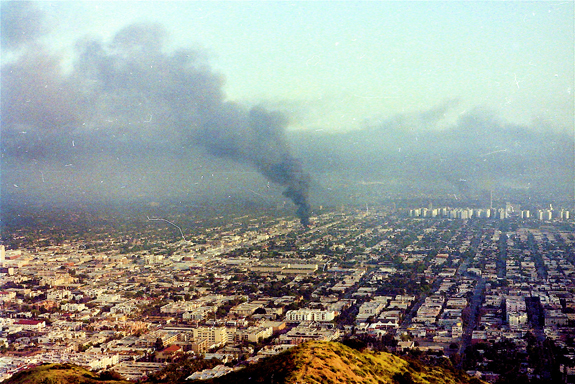In 1992, when I was eleven years old, I saw a Korean man on TV for the first time. He resembled the immigrants my family knew from church, the local swap meet, and the Asian grocery store. Stocky, with a buzz cut and large glasses, he wore the many-pocketed utility vest of the working-class entrepreneur. But something was wrong. He was tense, surrounded by smoke, his hand at a trigger. POP POP POP.
A thousand miles from my home in Tacoma, Los Angeles was on fire. Network TV looped harrowing images: Korean gunmen, trucker-victim Reginald Denny, smoldering city blocks, and teenagers making off with loot.
Korean Americans living on the West Coast at the time remember the first day, 4-29, or sa-i-gu, with time-freezing clarity.
The L.A. Riots (or uprising, civil unrest, or rebellion, depending) are often considered the first “multiethnic” riots. As a pivot point of race and urban relations, they constitute a resonant moment for immigrant America. Korean Americans living on the West Coast at the time remember the first day, 4-29, or sa-i-gu, with time-freezing clarity.
For many of us, the riots were a schooling in color and class. Our household, run by two working-class parents, was consumed by frantic arguments and phone calls about race, cities, and the distribution of wealth. There was talk of structural, large-scale discrimination, not merely individual prejudice or circumstance, which shaped the course of my life. Last summer, approaching the riots’ twentieth anniversary, I sought out the lessons of 1992. I was drawn in particular to the riots’ crucible in South Central, since refashioned as ‘South L.A.,’ though its infamy and boundaries–set by highways and thoroughfares–remain unchanged.
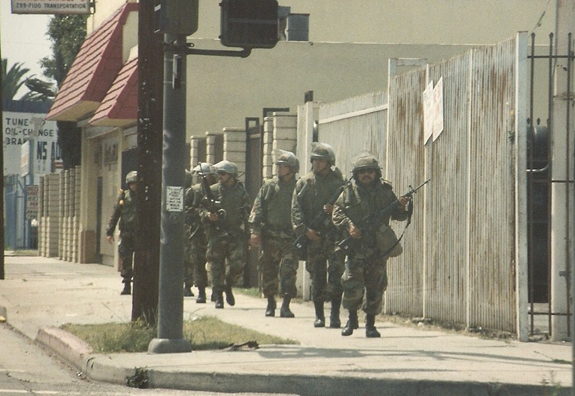
were the least affluent Korean-American merchants…”
–Raphael J. Sonenshein, Urban Affairs Review, 1996
“Geoorgiiiieee, I need a money order!” a woman yelled. “Georgie, nice orange shirt!” another exclaimed. He pretended not to hear.
For twenty-two years, George Chung has presided over these five fluorescent-lit aisles and the popular meat counter. Sturdy and middle-aged with thick black hair and glasses, he tends to speed-walk the length of the market, carrying inventory, documents, and cash. Loose change and keys jangle in his pockets.
Chung’s father, Taekook, known to all as “Papa,” bought Lee’s Market in December, 1990. The previous owner, a Chinese immigrant, had kept a baseball bat visibly on display behind the counter. Papa emigrated in his late forties with hardly any money and worked his way up in the corner-store business before buying his own. George eventually joined him and became the day-to-day manager. “Back then, in one month there would be three robberies,” Papa recalled. “After a year and a half, the riots happened.”
Father and son told their stories separately, but with the same, distinctly Korean shake of the head and a deep, teeth-sucking inhale: half a mournful sigh. Papa, a frail but dignified eighty-plus, wore a straw hat and all-white Nikes. “The riots happened because of Rodney King,” he said. His son traced their roots further back, to March 1991, when Korean shopowner Soon Ja Du shot and killed Latasha Harlins, a fifteen-year-old African American. Du received a de facto acquittal: suspended sentence, probation, a small fine, and community service. “Koreans really were unfriendly, and it led to an environment in which someone could shoot a customer over a box of orange juice,” Chung said.
Burned-out shopowners faced off with residents who saw in the razed aftermath a chance to reclaim their neighborhood.
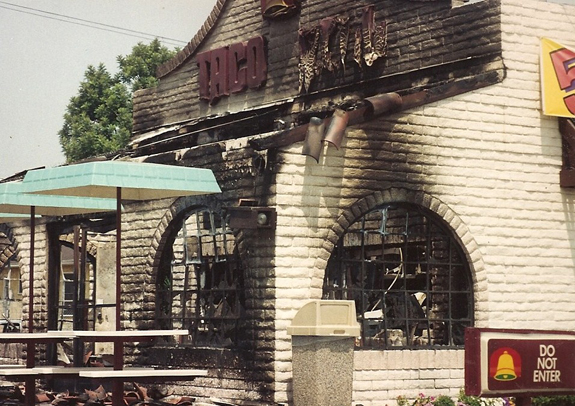
He remembered when the riots erupted. “On the first day, there wasn’t a fire. [The store] was just looted, and I thought ‘That’s the extent of it,’” he said. “I came home and the next day I returned and saw that it had been burned. I was so angry. This was an unthinkable event in America.” The police, he said, “were just watching.” The family’s losses totaled sixty thousand dollars, a third more than the prior year’s profits.
And yet, Chung said, the family had “no other thought than to come back in.” They crunched the numbers—insurance and loans—and prepared to do the construction themselves. What they did not expect was a lesson in bureaucracy and public relations. The Chungs got swept up in a fight for control of the city, or at least its grittier sections. Burned-out shopowners faced off with residents who saw in the razed aftermath a chance to reclaim their neighborhood. At the time, there were an astonishing seventeen liquor licenses for every square mile of South Central, compared to 1.6 per square mile in the rest of L.A. County. Activists organized by the Community Coalition for Substance Abuse Prevention and Treatment (“CoCo”) worked to ensure that liquor stores were denied re-permitting or, in the case of about thirty to fifty of them, converted into laundromats that the owners had little idea how to run.
Businesses wanting to rebuild were required to submit applications and appear at public hearings before the county Planning Commission. The hearing on Lee’s Market took place December 3, 1992, around what would have been the store’s two-year anniversary. In search of this history, I pulled the Chungs’ file from the municipal archives near Union Station. The folder was stuffed with photographs, blueprints, and legal memoranda. I was surprised by the prominent names: Congresswoman Maxine Waters, Korean-American attorney Angela Oh, and current Congresswoman Karen Bass, who was then the founding director of CoCo and its “Rebuild South-Central Without Liquor Stores” campaign.
Chung had never done any kind of petitioning. It was too overtly political, antithetical to the business mode. But with the legal counsel of Angela Oh, whose iconic, post-Riots appearance on Nightline gave voice to Korean America—armored in a bright yellow suit, Oh called the riot George H.W.’s “harvest” and the Black-Korean conflict “a myth created by the press”—Chung and his father hit the streets. “We went around to the neighbors to get signatures, and a competing [anti-liquor] coalition [CoCo] did the same in opposition. There was a lot of tension as we competed for signatures, but, and I know this is hard to believe, there wasn’t a single neighbor who opposed our store… We always treated our customers well. Like my father said, even people who pay with pennies are customers. So people didn’t resent us.”
The Chungs collected 416 signatures in support of their rebuilding petition, a show of force that put even CoCo at ease. The Planning Commission noted “the high standards of operation and community involvement brought about by the present operator.” Lee’s Market became the first business unanimously approved for reconstruction, but with a number of conditions:
Beer and wine sold only
No sale of cups, glasses
No game machine
Security lighting
Graffiti removal
No ice sold less than two pounds
Training program (liquor sales, cultural awareness training and safe business operating procedures)
No loitering or public drinking signs
Restrictions in place, the Chungs began rebuilding, and the shop reopened in April 1993, a year after the burning.
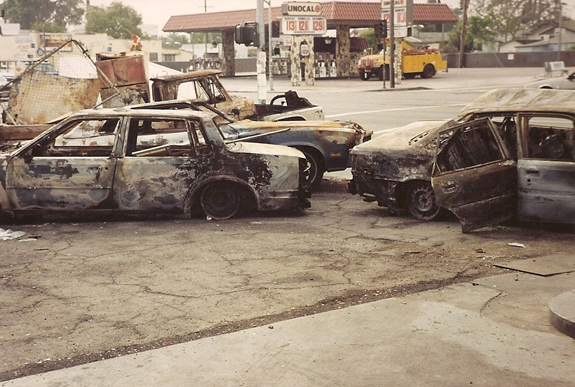
In the months following the riots, everyone hoped that the violence would be a wake-up call. In these liberal fantasies, Koreans would denounce racism and become something more than middleman opportunists. Latinos would stop taking jobs from blacks; stop resenting them their citizenship. African Americans would get educated, get jobs, and reclaim their community.
Nearly two decades later, with another round-numbered anniversary in sight, I wanted to ask whether things (jobs, economics, race, and police violence) felt different. What had changed? And what did it mean to make it through the riots and through all these years in South L.A.?
I asked Chung to introduce me to customers who survived the riots. He shook his head and said, “Nearly everyone from that time has either moved or passed away.” Of the 416 mostly African-American supporters who’d signed the Lee’s Market petition, only one was reachable at the phone number and address listed—the customer whose typewritten letter appeared in the archival file:
This letter is in support of the applicant’s application to rebuild. The market (4801 Avalon Blvd.), which had been in existence for many years, was well-known for its choice meats and fresh vegetables. George, the wonderful manager at the time of the (tragic) civil unrest, was very, very nice. He not only maintained the high standard of quality foods, but accepted Cents Off coupons, a practice one does not find outside of the supermarkets…
When I visited the author, Mrs. Olivia Sheppard, age ninety-five, she greeted me in a white flannel robe and matching slippers. Her tightly shuttered living room, decorated with a grand piano and dozens of framed family photos, felt like a time-machine.
“What do you remember about the riots?” I asked.
“Which ones?” she said, reminding me of her age and the 1965 riots in Watts. And then, before I could answer, she replied, “The fires, the fires.”
Mrs. Sheppard—she balked at being called anything else—still shops weekly at Lee’s Market, paying by personal check with the assistance of her more able-bodied, fifty-five-year-old son. “We didn’t want any more liquor stores on every block,” she said. But the Chungs “were just nice proprietors, and we just wanted them back. It’s simple.”
Since 1950, when the South Park area was middle-class, thriving, and all black, Mrs. Sheppard has lived in the same immaculate beige house. “When I first moved in, this neighborhood, it was terrific,” she said. “Forty-eighth Street had the most beautiful houses.” Now she’s “the only one left”; those who could afford to “go west” already did.
I kept hearing how much the neighborhood had changed—and usually people meant race. Chung and Papa say it was all African-American when they began, but according to the Census, the area around Lee’s Market was already about 60 percent Latino in 1990. By 2010, the black population had dwindled to 12 percent, with Latinos at 88 percent. Far from Beverly Hills, Malibu, and even downtown, I never saw a white person or Asian (besides the Chungs) in South L.A.
Chung’s inventory bears this out. I spotted a large jar of trampa, pickled pig snout, displayed prominently on the meat counter, as well as Mexican junk food, tomatillos, and a half-aisle of Latin American spices and dried chilies. Next to the bananas and potatoes, Chung installed a tiered glass case displaying fresh-baked Mexican pastries—pan de huevo, galleta, and piedra—three for one dollar.
Chung and Papa believe it’s now imperative to have all Spanish-speaking staff. “Earlier on, I absolutely had to have a black employee,” Chung said. “People would come and if they didn’t agree with something they’d say, ‘How can you be in a black neighborhood making money off us without employing blacks?’ Now there isn’t a single person asking why I don’t have a black employee.”
There’s no consensus on where black folks went, though there are dominant theories. Some maintain that they’ve moved east, seeking cheaper accommodations in San Bernardino and Riverside, toward the dusty Inland Empire. Academics and policymakers also speak of a “reverse migration” to the South and, like Mrs. Sheppard, note the outflow of middle-class blacks to the suburbs—the ongoing legacy of L.A.’s structural unemployment and violence, which sparked the riots.
“When I started working here, not too many Spanish people,” said a Lee’s Market worker whom I’ll call Alejandro. “Now black people and Spanish people get along better. Black people marry with Spanish people.”
In the middle of a long workday, in the back storeroom, Alejandro, a native Guadalajaran, ate cup ramen and deli meat, facing the microwave and a small glossy cut-out of the Virgin Mary taped to the wall. He said that one of the first delis he worked in the U.S., some twenty-five years ago, was also destroyed during the riots—when “America went down.”
“Conditions are the same now,” she said. “I don’t know why it’s not happening again.”
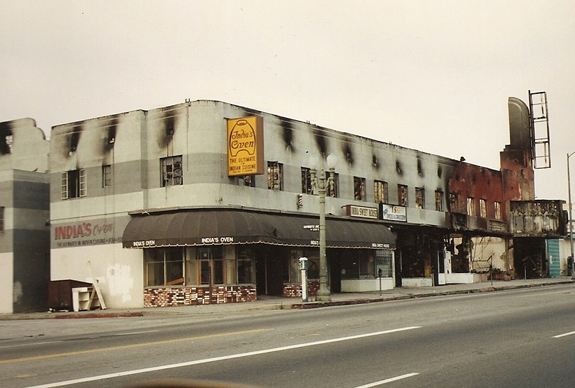
Outside Lee’s Market, I offered to help Rita Nunley with two plastic bags full of groceries. An African-American woman, hair tucked into a kerchief and eyes ringed with dark circles, she was a distant relation of Latasha Harlins.
In 1992, Nunley was working for the Post Office. She remembers her boss locking the staff inside the branch office until the coast was deemed clear. Rita had hoped the riots would change the city’s inequalities, but, “Conditions are the same now,” she said. “I don’t know why it’s not happening again.”
She knows many black Angelenos who have moved to the South. “Judging from my friends, people partly feel squeezed out because of the new immigrants. Especially around here, people give the jobs to the Hispanics for less wages, and [immigrants] tolerate more. If you go to the nearest McDonald’s, a job maybe a black teenager would have after school, part-time Hispanics are making it their permanent jobs, and there’s no room to move in, and everybody’s just staying put instead of progressing.” Particularly in this recessionary time, she said, “Everybody’s struggling, even Koreans are struggling, because everything’s going up so high, and it’s just leaving everything behind. Nobody can afford anything any more.”
A few days later, Chung aligned himself with customers like Nunley. “When things aren’t good, people like us at the bottom know first, and it’s really not good right now,” he said. (I wondered if Nunley would agree that they are both at the bottom.) Chung’s friend Jae Hong Kim, a fellow Korean merchant, identified a similar solidarity: “Economically, we live better than black people, but still we are minorities.”
Chung and Kim go way back, to their days as teenage immigrants in the 1970s. They lived on the same block and attended L.A. High. They also inherited their parents’ trades and fatigue. I met Kim at his laundromat in Huntington Park, a predominantly Mexican area just east of South L.A. Located at the corner of Florence and Malabar, it’s an old-fashioned place: coin-operated, dim-lit linoleum, wall-mounted TVs. Shy, sweaty children rapped on candy machines and nagged their mom for a few quarters. A young Latino worker mopped the floor.
Kim suggested burgers for lunch. We hadn’t left the parking lot when he started in on my driving. “Why are you so hesitant? You’re from New York! The traffic must be a lot worse there.” He said he’d never been to New York, or anywhere else for that matter. This is also the case for Chung, who hasn’t visited Korea since emigrating. “When I take a minute to reflect,” Kim said, “I think, ‘Why didn’t I travel when I was young?’ If I had the mindset I have now when I was young, I’d be traveling. Now, because business is so bad, I can’t even think about leaving.”
We drove down Pacific Avenue, which years ago, according to Kim, was as teeming a commercial stretch as Myeongdong market, one of the busiest in Seoul:
“A long time ago, if you came here, there were so many people crowded along this street. Now there are fewer people, the economy’s bad… And because of the immigration laws many people left.
“As I get to know America better, I realize it’s not the place I envisioned when I was young. Even as recently as college, I believed that America was the same for everyone. But as I get older and see more, I think this really isn’t our country. The feeling gets stronger and stronger. Wherever you go, there’s a discrimination that’s not quite visible.”
– Jamie, Guatemalan cashier in South L.A., August 2011
Outside the park’s community center, I met Daniel Esada, a portly, goateed Chicano lounging in the shade with his young daughter Leti, her friend, and the friend’s mother. Esada has lived around the corner from the park since 1990, when he arrived from Tijuana. “I didn’t know how it was here. I thought it was going to be fancy: white people, you know, the U.S.A.—you think it’s for white people. But when I came here, I saw gang members, Latinos, African Americans, drug dealers, and homeless. I was like, ‘This is U.S.A.?’”
He watched his daughter, a twiggy elementary school kid who, like her friend, was wearing a prominent hearing aid. Leti looked about six but “only knows two hundred words,” Esada explained; she’d just recently started special education. “I want her to learn to hear, to speak. I want her to go to university… I want better for my daughter.”
Esada had attended South Central’s Jefferson High when competition between blacks and new immigrants was lethal. “That’s why I started getting involved with that,” he says, that being a Latino gang. “It was racismo, blacks against Mexicans.” He remembers the various gangs and the territory claimed by each—the bravado, too, with some “kids dressed like rapper gangsters” and others like “rancheros.” “Thanks to the riots, a lot of bad things started happening. I noticed that more youngsters started getting involved in gangs and things like that… they started feeling, ‘We can do whatever.’”
Later Esada found religion and work, and now ministers to youth in gangs. “I’m proud to say I grew up in South Central. I’m probably one of the few… I mean, even though this is the ghetto, ’cause it still is.” There are more Latinos now, which he sees as a positive shift. “Why are African Americans not working? It’s because they didn’t like that kind of work. Our people like to work. Go to any factory downtown—I bet you anything that the majority are going to be Latino.” Daniel himself used to manage a Korean garment shop, where he saw himself as “a leader for my community.” This was a job no African American would do, he said.
The question of blacks, Latinos, and the work they do or don’t do never figured prominently in mainstream discussion of the riots, despite its critical importance to urban L.A. Throughout the city, Latinos form the bulk of the low-wage labor force and, increasingly, the general population. Nearly 49 percent of Los Angeles is now Latino, while African Americans make up only 9.6 percent. These crosscurrents and the sense of an ever-shrinking pie sharpen black-brown relations. The tension comes through in ordinary conversations. It’s there, too, in hate crimes statistics and rhetorical battles over jobs, public space and Congressional seats.
This delicate balance of power can be seen in the 2010 merger of two union locals: L.A.’s majority Latino janitors and majority African-American security guards. I met with Robert Branch, a security guard and executive board member of the new union, over a dinner of catfish, greens, and cornbread at Bertha’s, a soul food diner in Inglewood.
Branch, an African-American native of Baltimore, looks a decade younger than his fifty-one years, wearing a crisp white button-up shirt and tennis shoes, a shaved head, and warm countenance. He’s retained a Southern tempo and laughs easily, but he expressed real concerns about the merged union. “We don’t want to feel like stepchildren, like we’re going to get crumbs,” he said. He worried that the union leadership was unfairly prioritizing the needs of Latino janitors over African-American security guards—that it had gone from a commitment to “black and brown” to just “brown, even in the speeches.”
The history goes back to when the now-brown janitors were black. Fifty years ago, African Americans held unionized, solid-paying janitorial jobs in the high-rises of L.A.’s “downtown fortress.” But as rapid deindustrialization decimated the car and rubber factories staffed by legatees of the Great Migration, custodial positions became casualized, then Latinized—among the many setbacks to the 1960s and 1970s black working class.
In the late 1980s, the low-wage, mostly Latino janitors began to organize through the Service Employees International Union’s (SEIU) national Justice for Janitors campaign. As the janitors negotiated their first, second, then third collective bargaining agreements, bringing up their wages and benefits, another group of workers laboring in the same corporate towers looked on with envy and resentment.
Downtown L.A.’s corporate offices were guarded by African Americans who possessed the necessary English fluency and citizenship. Salaries were abysmal, benefits scant, and turnover correspondingly high. When an organizer reached Branch on the graveyard shift, he gladly signed a union card.
To win their union campaign, Branch and thousands of his fellow guards needed community support, but African Americans were wary of the SEIU, due in part to the history of the black janitors’ losing their jobs to Latinos. Organizer Lola Smallwood-Cuevas, who now directs the Los Angeles Black Worker Center, courted black churches, civil rights activists, and politicians, including Congresswoman Waters and Pastor Chip Murray of the First AME Church, prominent post-riots spokespeople. Eventually, they all came on board. “The black community was galvanized around us,” Branch explained, “because the old-timers knew of the plight regarding the janitors. They knew former janitors and how their jobs were taken away.”
After years of militant, coordinated actions, in 2008 the union’s four thousand guards signed a four-year contract with the city’s top security companies. “This was like a breath of fresh air, to have this African-American group of lower-income workers—because of the community and the churches and the elected officials—do better in their lives,” Branch said. “We were treated royally. As a matter of fact, I kind of miss those days.”
Branch’s home speaks to the modest gains of the union. He lives in a shared house in Inglewood, near LAX. Bedsheet curtains served as partitions here and there, and hand-washed socks were draped over the edges of beds and chairs. Branch relies exclusively on public transportation, no small feat in L.A. In his view, the guards’ initial, 2008 contract was an important symbolic victory, but “there’s a long way to go in terms of the actual wages and working conditions these security guards enjoy.” He also recognized the symbolic “bonds between black and brown,” which is where the struggle now lies.
When I first heard the term “black-brown conflict,” I assumed brown included Asians, not just Latinos. My long-distance experience of the riots centered on the black-Korean dynamic and perhaps exaggerated the significance of Asians in the politics of non-white L.A. The city has a large East Asian underclass, but Latinos and blacks are more likely to see Chinese and Koreans as shopkeepers and bosses than fellow travelers. After the riots, efforts like the short-lived Black-Korean Alliance succumbed to politicized strife.
The non-profit Koreatown Immigrant Workers Alliance (KIWA), established just before the riots, has tried to unite more of this working class. Koreatown, a sprawling neighborhood of Hangul signage, Seoul-style malls, BBQ restaurants, and downmarket apartments for newly arrived Mexicans and Central Americans, was hit hard by the riots. According to KIWA director Alexandra Suh, a former professor who succeeded founder Danny Park last year, the group “wanted to challenge the perception of violence-prone storeowners” and organize across race. In the 1990s, she says, “many of the Koreans you came across in public spaces were shop owners whose knowledge of people of other races and American race relations were structured by the military and the entertainment industry.” Today things are different: “Others’ experience of Koreans and Koreans’ experience of others have opened up as the Korean community has gone through a generational shift.”
Koreatown itself has become a majority Latino neighborhood, at least in terms of workers and residents. Recently, a small section near Third Street and South New Hampshire was carved out as “Little Bangladesh.”
“I went to a quinceañera there,” she said.
“In that warehouse?”
“Yeah, they rent them out for that now. I just remember thinking how much it smelled like oil.”
We later went to the Alameda Swap Meet, winding through shouting food vendors, mariachi synth, and bright demijohns of orangeade, horchata, and watermelon juice. Inside the maze of shops, white communion dresses and decidedly less demure quinceañera gowns hung in clear plastic casing. Most of the stands were staffed by Mexicans, but the woman who sold us cheap sunglasses was Korean. I asked about the other owners—all Korean, she said.
With her and many others, in what used to be called South Central, Huntington Park, Inglewood, and Koreatown, I was playing conversational middleman. “We own it all.” “They took the jobs.” “They expect the government to do everything.” “They live dozens to a house.” “I’d leave if I could.” “They’re addicted to drugs.” “They like working for us.” “I like working for them.”
I stopped by Lee’s Market on the way home, but it was already closed. A neighbor, Tudy Lewis, caught me lingering. “You looking for Lee?” she asked (most assume that’s Chung’s last name). “I loooove Lee’s Market,” she gushed. “We can go in here and get credit. He’s a good person. He’s here for the neighborhood. He made it through the riots—who else made it through the riots?”
It was, I remembered, the question I’d come to answer.
